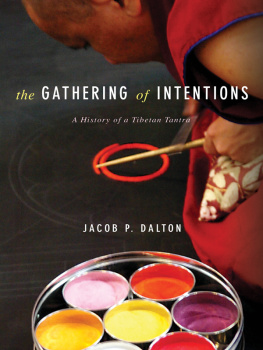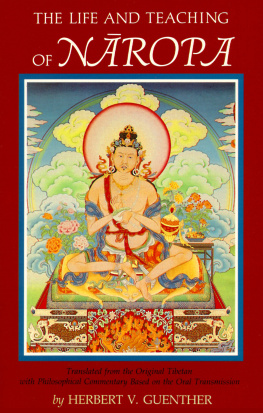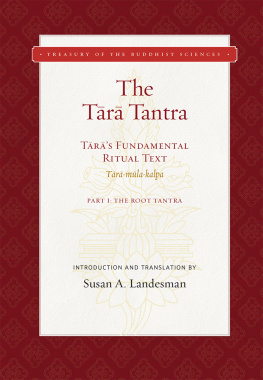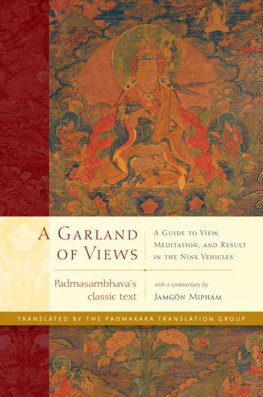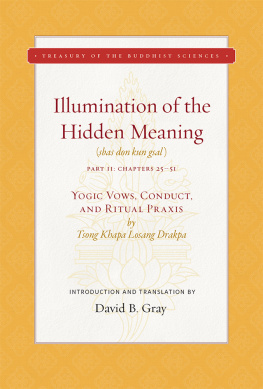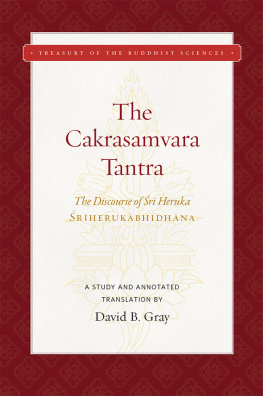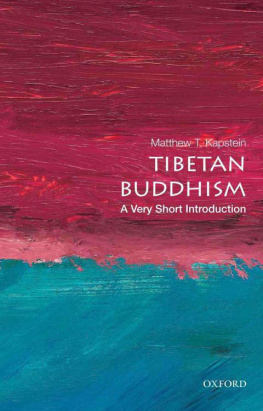THE GATHERING OF INTENTIONS
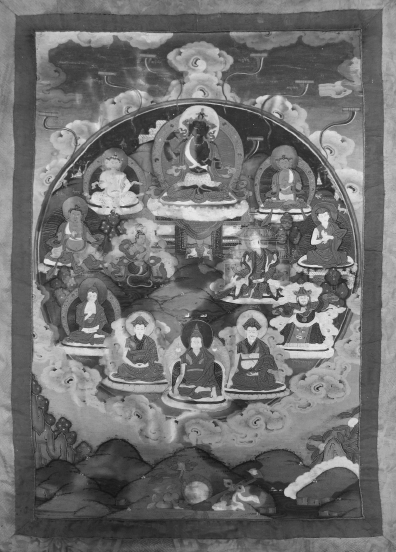
, King Dza is not counted among the five excellent ones receiving the teaching atop Malaya. At the end of Vajrapis sermon, however, Rvaa, who inscribes the buddhas words in melted beryl on golden pages, places the resulting tantra within a casket and hides it the sky. Through the blessings of this symbolic transmission of the conquerors, at the same moment, King Dza receives the same casket as it descends out of the sky onto the roof of his palace, as depicted directly above the king, thus inaugurating the hearing transmission of persons and thence all the lineages of tantric Buddhism. The comprehensiveness of Vajrapis teaching is represented by six volumes, embodying the six classes of tantras from Kriy to Atiyoga, seen descending from the sky at the top of the painting. The lower three classes, of Kriy, Ubhay, and Yoga, each descend on a light ray to a specific Indian locale: Vraas, the Blazing Mountain (Me ri bar ba), and the Craving Wood (Sred tshal), respectively, while the destinations of the higher three are left unnamed. In the paintings lower half sit five Tibetan teachers, all important figures in the history of the Nyingma School. From left to right, they are: Nyak Lotsawa Yesh Zhnu, Zurch kya Jungn, Longchenpa, Terdak Lingpa, and Nupchen Sangy Yesh.
THE GATHERING OF INTENTIONS
A History of a Tibetan Tantra
Jacob P. Dalton
Columbia University Press New York
Columbia University Press
Publishers Since 1893
New York Chichester, West Sussex
cup.columbia.edu
Copyright 2016 Columbia University Press
All rights reserved
E-ISBN 978-0-231-54117-6
Cataloging-in-Publication Data available from the Library of Congress
A Columbia University Press E-book.
CUP would be pleased to hear about your reading experience with this e-book at .
Cover design by Noah Arlow
References to websites (URLs) were accurate at the time of writing. Neither the author nor Columbia University Press is responsible for URLs that may have expired or changed since the manuscript was prepared.
CONTENTS
My research on this project began in the spring of 1997. While staying at Namdrling monastery in south India, I began to work my way through the Gathering of Intentions, with the help of Nupchen Sangy Yeshs late ninth-century commentary, the . By the time I returned to the United States, I was confused but also captivated by the vast and mysterious unexplored territory I had glimpsed. Over the next year and a half, I assembled a small library of everything written on the Gathering of Intentions that I could find. Finally, in October 1998, I was ready to return to India and my research proper. On the advice of Gene Smith, I decided to begin with Pema Trinls collection of biographies of the lamas belonging to the Gathering of Intentions lineage.
In the winter of 199899, while still reading through this collection under the supervision of Khenpo Chwang at the Namgyal Institute of Tibetology in Gangtok, Sikkim, I learned that the current head of the Nyingma School, Penor Rinpoche, was in town, at the behest of the Sikkimese royal family. This was fortunate, as I was having an extraordinarily hard time locating anyone experienced in the Gathering of Intentions with whom I could study, and I had heard that Penor Rinpoche was the last living holder of the complete lineage, having received its initiations, the reading transmission, and the explanations. (I later learned that Thubzang Rinpoche of Pelyul monastery in eastern Tibet also held the lineage.)
On his final morning before leaving Gangtok, Penor Rinpoche granted me an audience in his hotel room, with many members of the local government present. I prostrated three times and in my halting Tibetan explained my predicament. I was quickly reprimanded that I should not have been reading the text in the first place without having received the initiation. When I asked if Penor Rinpoche would grant me that initiation, he told me that he would be in the United States the following summer and I should meet him there.
It just so happened that I was back for a brief visit that summer. One day, while staying with friends in upstate New York, I learned that Penor Rinpoche had just opened a new center only a few hours away and was visiting there at that very time. On a hot afternoon, up a small, dusty road, I found Penor Rinpoche sitting alone in an upstairs room in an isolated farmhouse that was otherwise silent and strewn with slumbering monks. After prostrating three times, I reminded Penor Rinpoche of our meeting in Gangtok and that he had instructed me to come find him here, in the United States. Again I requested the initiation. This time he responded, somewhat more kindly, that the following October he would be at his monastery in south India, and that I should come see him there. I thanked him and drove away.
Returning to India, I made sure to arrive at Namdrling monastery, located in the Tibetan settlement of Bylakuppe, a few hours from Mysore, at the proper time. The Dalai Lama had just left, having helped Penor Rinpoche with the consecration of his grand new temple, and Penor Rinpoche was preparing to leave for Singapore. I gained entrance to his room, and after prostrating three times, reminded him of our first meeting in Gangtok and how he had told me to come see him in the United States the following summer. Then I reminded him of our second meeting in the isolated farmhouse and how he had told me to come see him here, in Bylakuppe, in October. Again I asked him for the initiation. This time he responded with exasperation, telling me to go and wait in the monasterys guesthouse until summoned.
I waited for four days. One morning I awoke to find the monastery bustling with preparations for an initiation ceremony that was to begin later that day. I went in to see Rinpoche and asked if this had anything to do with the request I had made. It did indeed. He impressed upon me the seriousness of the event, that he had postponed his trip to Singapore just for this, and that I should not take this initiation in order to become famous. Certainly, he said, I should not publish any photos of the elaborate sand mandala that had been constructed for the event and hidden behind silk brocade curtains. Sufficiently cowed, I crept out of the room.
Around three thousand people attended the ceremony. For three full days, Penor Rinpoche granted the hundreds of initiations for all nine vehicles of the Nyingma Schools teachings. At the end, as the blessings were being distributed while Penor Rinpoche sat upon his throne in meditation, a hard rain fell. Finally, as Rinpoche raised himself up to leave, the rains stopped as suddenly as they had begun, leaving the monastery grounds cleansed and cool.
Over the months that followed, in Bodhgaya and Kathmandu, I read through the various writings by Katok Dampa Dshek, paying particular attention to his influential and his Summary, a detailed outline of the entire Gathering of Intentions that itself fills about 146 folio sides. Meanwhile, I still had not found anyone who knew the Gathering of Intentions apart from Penor Rinpoche, who obviously could not afford the time to read with the likes of me. Finally, Khenpo Pema Sherab, the abbot of Penor Rinpoches Namdrling monastery, agreed to help me, even though he himself had never read the text. For four months in the spring of 2000, we sat together for two or three hours every day in his room at Shuksep nunnery in Dharamsala, picking our way through the more important parts of the tantra. I used my translation of Dampa Dsheks

